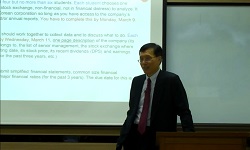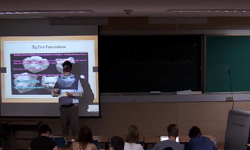In this paper, we analyse empirically the effect of private equity financing on R&D investment of innovative small and medium sized enterprises (SMEs) listed on Kosdaq Market of Korea Exchange. Korea Small and Medium Business Administration (SMBA) des...
http://chineseinput.net/에서 pinyin(병음)방식으로 중국어를 변환할 수 있습니다.
변환된 중국어를 복사하여 사용하시면 됩니다.
- 中文 을 입력하시려면 zhongwen을 입력하시고 space를누르시면됩니다.
- 北京 을 입력하시려면 beijing을 입력하시고 space를 누르시면 됩니다.

혁신형 중소기업의 사모주식발행이 R&D 투자에 미치는 영향 = Regular Researches : The Effect of Private Equity Financing on R&D Investment of Innovative Small and Medium Sized Enterprises
한글로보기https://www.riss.kr/link?id=A99725705
- 저자
- 발행기관
- 학술지명
- 권호사항
-
발행연도
2013
-
작성언어
-
-
주제어
혁신형 중소기업 ; 사모주식발행 ; R&D 투자 ; 현금자산 ; 운전자본 ; Innovative SMEs ; Private Equity Financing ; R&D Investment ; Cash Asset ; Working Capital
-
KDC
300
-
등재정보
KCI등재
-
자료형태
학술저널
- 발행기관 URL
-
수록면
61-88(28쪽)
-
KCI 피인용횟수
2
- 제공처
- 소장기관
-
0
상세조회 -
0
다운로드
부가정보
다국어 초록 (Multilingual Abstract)
In this paper, we analyse empirically the effect of private equity financing on R&D investment of innovative small and medium sized enterprises (SMEs) listed on Kosdaq Market of Korea Exchange. Korea Small and Medium Business Administration (SMBA) designates venture business, innobiz firms, and management innovative firms as innovative SMEs for policy purpose. The main results of this study can be summarized as follows. Private equity financing has a positive and significant effect on R&D investment, and cash asset change and working capital change have negative and significant effects on R&D investment. This implies that SMEs use part of private equity financing for current R&D investment, and hold remaining part of private equity financing as ‘precautionary’ cash asset and working capital until promising R&D investment opportunities will be found, and ultimately use large part of private equity financing for future R&D investment. However, private equity financing has a positive and significant effect on R&D investment of innovative SMEs, while it is insignificant for non-innovative ones. Moreover, private equity financing has a positive and significant effect on both asset-counted R&D investment and cost-counted R&D investment of innovative SMEs, while it is insignificant for non-innovative ones. Asset-counted R&D investment is counted as the intangible assets in the balance sheet, while cost-counted R&D investment is counted as the current expenses in the income statement. The intangible assets created by asset-counted R&D investment may act as an innovative driver that can have a greater multiplier effect on the firm value than the tangible assets. In conclusion, this paper shows evidence that SMEs use private equity financing to fund R&D investment in the existence of the asymmetric information. Moreover, innovative SMEs use more private equity financing to fund R&D investment than non-innovative ones. These findings suggest a new policy implication into how private equity financing can be particularly valuable to promote R&D investment of innovative SMEs such as venture business, innobiz firms, and management innovative firms.
참고문헌 (Reference)
1 강효석, "사모주식발행의 장기성과 : 발행기업과 인수기업 주주의 부에 미친 영향을 중심으로" 한국재무학회 17 (17): 203-241, 2004
2 강준구, "국내기업 자본조달정책의 효율성에 관한 실증연구 : 기업집단의 사모주식발행과 기업가치" 한국재무학회 16 (16): 69-113, 2003
3 Fazzari, S. M., "Working capital and fixed investment : New evidence on financing constraints" 24 (24): 328-342, 1993
4 Brown, J., "Why has the investment-cash flow sensitivity declined so sharply? Rising R&D and equity market developments" 33 (33): 971-984, 2009
5 Floros, I., "Why do so many firms issue private equity repeatedly? On the information content of multiple PIPE offerings" Iowa State University 2011
6 Ferreira, M. A., "Why do firms hold cash? Evidence from EMU countries" 10 (10): 295-319, 2004
7 Hall, B., "The financing of R&D and innovation"
8 Kim, C. S, "The determinants of corporate liquidity : Theory and evidence" 33 (33): 305-334, 1998
9 Chen, H., "The choice of equity selling mechanisms : PIPEs versus SEOs" 13 (13): 538-563, 2010
10 Breusch, T. S., "The Lagrange multiplier test and its applications to model specification in econometrics" 47 (47): 239-253, 1980
1 강효석, "사모주식발행의 장기성과 : 발행기업과 인수기업 주주의 부에 미친 영향을 중심으로" 한국재무학회 17 (17): 203-241, 2004
2 강준구, "국내기업 자본조달정책의 효율성에 관한 실증연구 : 기업집단의 사모주식발행과 기업가치" 한국재무학회 16 (16): 69-113, 2003
3 Fazzari, S. M., "Working capital and fixed investment : New evidence on financing constraints" 24 (24): 328-342, 1993
4 Brown, J., "Why has the investment-cash flow sensitivity declined so sharply? Rising R&D and equity market developments" 33 (33): 971-984, 2009
5 Floros, I., "Why do so many firms issue private equity repeatedly? On the information content of multiple PIPE offerings" Iowa State University 2011
6 Ferreira, M. A., "Why do firms hold cash? Evidence from EMU countries" 10 (10): 295-319, 2004
7 Hall, B., "The financing of R&D and innovation"
8 Kim, C. S, "The determinants of corporate liquidity : Theory and evidence" 33 (33): 305-334, 1998
9 Chen, H., "The choice of equity selling mechanisms : PIPEs versus SEOs" 13 (13): 538-563, 2010
10 Breusch, T. S., "The Lagrange multiplier test and its applications to model specification in econometrics" 47 (47): 239-253, 1980
11 Himmelberg, C., "R&D and internal finance : A panel study of small firms in high-tech industries" 76 (76): 38-51, 1994
12 Chamberlain, G., "Panel Data, In Handbook of Econometrics 2" Chamberlain, G. and 1984
13 Martos-Vila, M., "PIPEs : A theory of private versus public placements in Public Firms" University of California 2011
14 Anderson, C., "Investor objective and contractural design : Evidence from the PIPE deals" State University of New York at Albany 2010
15 Dittmar, A., "International corporate governance and corporate cash holdings" 38 (38): 111-133, 2003
16 Brophy, D., "Hedge funds as investors of last resort?" 22 (22): 541-574, 2009
17 Kayhan, A., "Firms' histories and their capital structure" 83 (83): 1-32, 2007
18 Calomiris, C. W., "Firm heterogeneity, internal finance, and credit rationing" 100 (100): 90-104, 1990
19 Chaplinsky, S., "Financing under extreme uncertainty : Evidence from private investments in public equities" 23 (23): 2789-2820, 2010
20 Brown, J, "Financing innovation and growth : Cash flow, external equity and the 1990s R&D boom" 64 (64): 151-185, 2009
21 Bengtsson, O., "Financial contracts in PIPE offerings : The role of expert placement agents" University of Illinois 2010
22 Billett, M., "Do investor identity and contract terms interact? Evidence from the wealth effects of private placements" Indiana University 2011
23 Stiglitz, J. E., "Credit rationing in markets with imperfect information" 71 (71): 393-410, 1981
24 Ozkan, A., "Corporate cash holdings : An empirical investigation of UK companies" 28 (28): 2103-2134, 2004
25 Brown, J., "Cash holdings and R&D smoothing" 17 (17): 694-709, 2011
26 Ellis, K., "Are PIPEs a bet on growth options?" Australian National University 2008
27 Brown, J., "Access to private equity and real firm activity : Evidence from PIPEs" 18 (18): 151-165, 2012
동일학술지(권/호) 다른 논문
-
- 한국중소기업학회
- 조봉현 ( Bong Hyun Cho )
- 2013
- KCI등재
-
- 한국중소기업학회
- 윤병섭 ( Byung Seop Yoon )
- 2013
- KCI등재
-
성공적인 가업승계를 위한 정책: 리더십 이전을 중심으로
- 한국중소기업학회
- 남영호 ( Young Ho Nam )
- 2013
- KCI등재
-
대출금리 상한선 인하가 중기대출시장에 미치는 영향에 관한 연구
- 한국중소기업학회
- 서경란 ( Kyong Ran Seo )
- 2013
- KCI등재
분석정보
인용정보 인용지수 설명보기
학술지 이력
| 연월일 | 이력구분 | 이력상세 | 등재구분 |
|---|---|---|---|
| 2027 | 평가예정 | 재인증평가 신청대상 (재인증) | |
| 2021-01-01 | 평가 | 등재학술지 유지 (재인증) |  |
| 2018-01-01 | 평가 | 등재학술지 유지 (등재유지) |  |
| 2015-01-01 | 평가 | 등재학술지 유지 (등재유지) |  |
| 2011-01-01 | 평가 | 등재학술지 유지 (등재유지) |  |
| 2009-01-01 | 평가 | 등재학술지 유지 (등재유지) |  |
| 2007-01-01 | 평가 | 등재학술지 유지 (등재유지) |  |
| 2005-01-01 | 평가 | 등재학술지 유지 (등재유지) |  |
| 2002-01-01 | 평가 | 등재학술지 선정 (등재후보2차) |  |
| 1999-07-01 | 평가 | 등재후보학술지 선정 (신규평가) |  |
학술지 인용정보
| 기준연도 | WOS-KCI 통합IF(2년) | KCIF(2년) | KCIF(3년) |
|---|---|---|---|
| 2016 | 1.08 | 1.08 | 1.07 |
| KCIF(4년) | KCIF(5년) | 중심성지수(3년) | 즉시성지수 |
| 1.1 | 1.13 | 1.521 | 0.36 |




 KCI
KCI KISS
KISS






